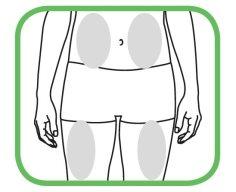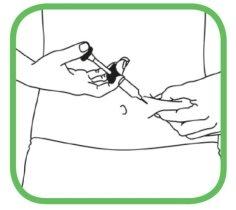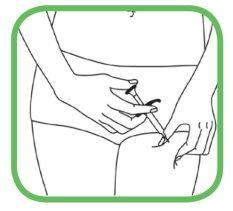
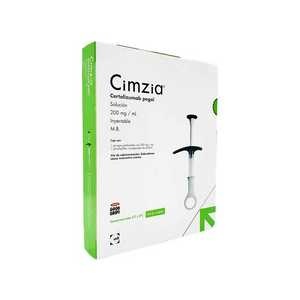
Цимзія 200 мг розчин для ін'єкцій у попередньо заповненому шприці


Інструкція із застосування Цимзія 200 мг розчин для ін'єкцій у попередньо заповненому шприці
Введення
Опис: інформація для користувача
Цимзія 200 мг розчин для ін'єкцій у картриджі для диспенсера доз
цертолізумаб пегол
Прочитайте уважно весь опис перед тим, як почати використовувати цей лікарський засіб, оскільки він містить важливу інформацію для вас.
- Збережіть цей опис, оскільки вам може знадобитися знову його прочитати.
- Якщо у вас виникли питання, проконсультуйтеся з вашим лікарем, фармацевтом або медсестрою.
- Цей лікарський засіб призначений тільки для вас, і його не слід давати іншим людям, навіть якщо вони мають такі самі симптоми, як у вас, оскільки це може їм нашкодити.
- Якщо ви відчуваєте побічні ефекти, проконсультуйтеся з вашим лікарем, фармацевтом або медсестрою, навіть якщо це побічні ефекти, які не наведені в цьому описі. Див. розділ 4.
Зміст опису
- Що таке Цимзія і для чого вона використовується
- Що потрібно знати перед тим, як почати використовувати Цимзію
- Як використовувати Цимзію
- Можливі побічні ефекти
- Зберігання Цимзії
- Зміст упаковки та додаткова інформація
Ваш лікар також дасть вам «Картку інформації для пацієнта», яка містить важливу інформацію про безпеку, яку потрібно знати перед тим, як вам буде введено Цимзію, і під час лікування цим лікарським засобом. Збережіть цю «Картку інформації для пацієнта» при собі.
1. Що таке Цимзія і для чого вона використовується
Цимзія містить активну речовину цертолізумаб пегол, фрагмент людського антитіла. Антитіла - це білки, які розпізнають і специфічно зв'язуються з іншими білками. Цимзія зв'язується з певним білком, називається фактором некрозу пухлини α (TNFα). Таким чином, цей TNFα блокується Цимзією, що зменшує запалення при захворюваннях, таких як ревматоїдний артрит, аксіальний спондилоартрит, псоріатичний артрит і псоріаз. Лікарські засоби, які зв'язуються з TNFα, також називаються блокаторами TNF.
Цимзія використовується у дорослих для лікування наступних запальних захворювань:
- ревматоїдний артрит,
- аксіальний спондилоартрит(включаючи анкілозуючий спондилоартрит і аксіальний спондилоартрит без радіографічних ознак анкілозуючого спондилоартриту),
- псоріатичний артрит
- псоріаз у плаці
Ревматоїдний артрит
Цимзія використовується для лікування ревматоїдного артриту. Ревматоїдний артрит - це запальне захворювання суглобів. Якщо у вас активний ревматоїдний артрит середньої або важкої ступеня, спочатку вам можуть призначити інші лікарські засоби, зазвичай метотрексат. Якщо ви недостатньо добре реагуєте на ці лікарські засоби, вам буде призначено Цимзію в поєднанні з метотрексатом для лікування ревматоїдного артриту. Якщо ваш лікар визначить, що метотрексат не підходить, Цимзія може бути призначена самостійно.
Цимзія в поєднанні з метотрексатом також може бути використана для лікування активного ревматоїдного артриту важкої ступеня без попереднього лікування метотрексатом або іншими лікарськими засобами.
Цимзія буде призначена в поєднанні з метотрексатом, вона використовується для:
- зменшення симптомів захворювання,
- зменшення пошкодження суглобів, викликаного захворюванням,
- поліпшення вашої фізичної функції та виконання повсякденних завдань.
Анкілозуючий спондилоартрит і аксіальний спондилоартрит без радіографічних ознак анкілозуючого спондилоартриту.
Цимзія використовується для лікування анкілозуючого спондилоартриту і аксіального спондилоартриту без радіографічних ознак анкілозуючого спондилоартриту (іноді називається аксіальним спондилоартритом без радіографічних ознак). Ці захворювання - це запальні захворювання хребта. Якщо у вас анкілозуючий спондилоартрит або аксіальний спондилоартрит без радіографічних ознак, спочатку вам будуть призначені інші лікарські засоби. Якщо ви недостатньо добре реагуєте на ці лікарські засоби, вам буде призначено Цимзію для:
- зменшення симптомів захворювання,
- поліпшення вашої фізичної функції та виконання повсякденних завдань.
Псоріатичний артрит
Цимзія використовується для лікування активного псоріатичного артриту. Псоріатичний артрит - це запальне захворювання суглобів, яке зазвичай супроводжується псоріазом. Якщо у вас активний псоріатичний артрит, спочатку вам будуть призначені інші лікарські засоби, зазвичай метотрексат. Якщо ви недостатньо добре реагуєте на ці лікарські засоби, вам буде призначено Цимзію в поєднанні з метотрексатом для:
- зменшення симптомів захворювання,
- поліпшення вашої фізичної функції та виконання повсякденних завдань.
Якщо ваш лікар визначить, що метотрексат не підходить, Цимзія може бути призначена самостійно.
Псоріаз у плаці
Цимзія використовується для лікування псоріазу у плаці середньої або важкої ступеня. Псоріаз у плаці - це запальне захворювання шкіри, яке також може вплинути на шкіру голови та нігтів.
Цимзія використовується для зменшення запалення шкіри та інших симптомів захворювання.
2. Що потрібно знати перед тим, як почати використовувати Цимзію
Не використовуйте Цимзію
- Якщо ви АЛЕРГІЧНІ(гіперчутливі) до цертолізумабу пеголу або до будь-якого іншого компонента цього лікарського засобу (перелічених у розділі 6).
- Якщо ви маєте тяжку інфекцію, включаючи ТУБЕРКУЛョЗ(активний ТБ).
- Якщо ви маєте СЕРЦЕВУ НЕДОСТАТНІСТЬсередньої або важкої ступеня. Повідоміть вашому лікареві, якщо ви мали або маєте серйозні проблеми з серцем.
Попередження та застереження
Перед тим, як почати лікування Цимзією, повідоміть вашому лікареві, якщо:
Алергічні реакції
- Якщо ви відчуваєте АЛЕРГІЧНІ РЕАКЦІЇ, такі як стиск у грудній клітці, труднощі з диханням, головокружіння, набряк або висип, припиніть використання Цимзії і негайно зверніться до вашого лікаря. Деякі з цих реакцій можуть виникнути після першої ін'єкції Цимзії.
- Якщо ви раніше мали алергічну реакцію на латекс.
Інфекції
- Якщо ви мали ПОВТОРЮВАНІ ІНФЕКЦІЇабо ОПОРТУНІСТИЧНІ ІНФЕКЦІЇабо інші захворювання, які збільшують ризик інфекцій (наприклад, лікування імунодепресивними засобами, які можуть зменшити вашу здатність захищатися від інфекцій).
- Якщо ви маєте будь-яку інфекцію або якщо у вас розвиваються симптоми, такі як гарячка, рани, втома або проблеми з зубами. Під час лікування Цимзією ви можете легше заразитися інфекцією, включаючи тяжкі інфекції, або в рідких випадках інфекції, які можуть загрожувати вашому життю.
- Були описані випадки ТУБЕРКУЛョЗУ (ТБ)у пацієнтів, які приймали Цимзію, ваш лікар буде шукати ознаки або симптоми туберкульозу перед тим, як почати ваше лікування Цимзією. Це включатиме складання детального медичного анамнезу, радіографію грудної клітки та тест на туберкульоз. Виконання цих тестів повинно бути записано в вашій «Картці інформації для пацієнта». Якщо у вас буде діагностовано латентний туберкульоз (неактивний), вам може знадобитися приймати відповідний лікарський засіб проти туберкульозу перед тим, як почати лікування Цимзією. У рідких випадках туберкульоз може розвинутися під час лікування, навіть якщо ви приймали профілактичне лікування проти туберкульозу. Дуже важливо, щоб ви повідомили вашому лікареві, якщо ви мали туберкульоз або були в контакті з пацієнтом, який мав туберкульоз. Якщо у вас з'являться симптоми туберкульозу (тривала кашель, вагова недостатність, загальна слабкість, субфебрильна температура) або будь-якої іншої інфекції під час або після закінчення лікування Цимзією, негайно зверніться до вашого лікаря.
- Якщо ви під загрозою інфекції ВІРУСОМ ГЕПАТИТУ Б (ВГБ), якщо ви є носієм ВГБ або якщо у вас є активна інфекція з ВГБ, Цимзія може збільшити ризик реактивації ВГБ у осіб, які є носіями цього вірусу. Якщо це відбувається, вам потрібно припинити використання Цимзії. Ваш лікар повинен провести тест на ВГБ перед тим, як почати ваше лікування Цимзією.
Серцева недостатність
- Якщо ви маєте СЕРЦЕВУ НЕДОСТАТНІСТЬлегкої ступеня і приймаєте Цимзію, ваш лікар повинен постійно спостерігати за вашою серцевою недостатністю. Дуже важливо, щоб ви повідомили вашому лікареві, якщо ви мали або маєте серйозні проблеми з серцем. Якщо у вас розвиваються нові симптоми серцевої недостатності або погіршуються існуючі симптоми (наприклад, труднощі з диханням або набряк ніг), вам потрібно негайно звернутися до вашого лікаря. Ваш лікар вирішить, чи потрібно припинити лікування Цимзією.
Пухлина
- Рідко, але були описані випадки певних типів ПУХЛИНИу пацієнтів, які приймали Цимзію або інші лікарські засоби, які блокують TNF. Люди з більш серйозним ревматоїдним артритом, які мають захворювання протягом тривалого часу, можуть мати підвищений ризик розвитку лімфоми, типу пухлини, яка впливає на лімфатичну систему. Якщо ви приймаєте Цимзію, ви можете збільшити ризик розвитку лімфоми або інших типів пухлини. Крім того, були описані рідкі випадки пухлини шкіри типу не-меланоми у пацієнтів, які приймали Цимзію. Повідоміть вашому лікареві, якщо під час або після лікування Цимзією у вас з'являються нові ураження шкіри або якщо існуючі ураження змінюють свій вигляд. Були випадки пухлини, включаючи рідкі типи, у дітей і підлітків, які приймали лікарські засоби, які блокують TNF, які іноді закінчувалися смертю (див. нижче «Використання у дітей та підлітках»).
Інші захворювання
- Пацієнти з хронічною обструктивною хворобою легень (ХОХЛ) або ті, хто палить багато, можуть мати підвищений ризик розвитку пухлини при лікуванні Цимзією. Якщо у вас ХОХЛ або ви палите багато, вам потрібно проконсультуватися з вашим лікарем, чи підходить лікування лікарським засобом, який блокує TNF, для вашого випадку.
- Якщо у вас є захворювання нервової системи, chẳng hạn як розсіяний склероз, ваш лікар вирішить, чи потрібно використовувати Цимзію.
- У деяких пацієнтів організм може бути нездатний виробляти достатню кількість клітин крові, які допомагають організму захищатися від інфекцій або тих, які сприяють зупиненню кровотечі. Якщо у вас тривала гарячка, синяки або ви легко кровоточите або дуже бліді, негайно зверніться до вашого лікаря. Ваш лікар може вирішити припинити лікування Цимзією.
- Рідко, але можуть з'явитися симптоми захворювання, яке називається лупус (наприклад, тривалий висип, гарячка, біль у суглобах та втома). Зверніться до вашого лікаря, якщо ви відчуваєте ці симптоми. Ваш лікар може вирішити припинити лікування Цимзією.
Вакцинація
- Повідоміть вашому лікареві, якщо вам була введена або буде введена вакцина. Деякі вакцини (живі) не повинні бути введені під час лікування Цимзією.
- Деякі вакцини можуть викликати інфекції. Якщо ви приймали лікування Цимзією під час вагітності, ваш дитина може мати підвищений ризик інфекції до приблизно п'яти місяців після останньої дози, яку ви прийняли під час вагітності. Дуже важливо, щоб ви повідомили лікарям вашої дитини та іншим медичним працівникам про ваше лікування Цимзією, щоб вони могли вирішити, коли ваша дитина повинна бути вакцинована.
Хірургічні або стоматологічні втручання
- Повідоміть вашому лікареві, якщо вам буде проведено хірургічне або стоматологічне втручання. Повідоміть хірурга або стоматолога, який буде проводити втручання, що ви приймаєте Цимзію, показавши йому вашу «Картку інформації для пацієнта».
Діти та підлітки
Використання Цимзії не рекомендується у пацієнтів молодших 18 років.
Використання Цимзії з іншими лікарськими засобами
Невикористовуйте Цимзію, якщо ви приймаєте наступні лікарські засоби для лікування ревматоїдного артриту:
- анакінра
- абатацепт
Якщо у вас виникли питання, проконсультуйтеся з вашим лікарем.
Цимзія може бути використана разом з:
- метотрексатом,
- кортикостероїдами або
- лікарськими засобами для лікування болю, включаючи нестероїдні протизапальні лікарські засоби (також називаються НПЗЛ).
Повідоміть вашому лікареві або фармацевту, якщо ви приймаєте, недавно приймали або можете приймати будь-який інший лікарський засіб.
Вагітність та лактація
Якщо ви вагітні або годуєте грудьми, вважаєте, що можете бути вагітною або плануєте вагітність, проконсультуйтеся з вашим лікарем або фармацевтом перед тим, як використовувати цей лікарський засіб.
Цимзія повинна бути використана під час вагітності тільки у випадках, коли це явно необхідно. Якщо ви жінка репродуктивного віку, проконсультуйтеся з вашим лікарем про використання відповідних контрацептивних заходів під час прийому Цимзії. Для жінок, які планують вагітність, контрацепцію можна розглядати протягом 5 місяців після останньої дози Цимзії.
Якщо ви приймали лікування Цимзією під час вагітності, ваша дитина може мати підвищений ризик інфекції. Дуже важливо, щоб ви повідомили лікарям вашої дитини та іншим медичним працівникам про ваше лікування Цимзією перед тим, як ваша дитина буде вакцинована (для більшої інформації див. розділ про вакцинацію).
Цимзія може бути використана під час лактації.
Водіння автомобіля та використання машин
Вплив Цимзії на здатність водити автомобіль та використовувати машини є малим. Можуть виникнути головокружіння (включаючи відчуття, що кімната обертається, розмитість зору та втома) після прийому Цимзії.
Цимзія міститьацетат натрію та хлорид натрію
Цей лікарський засіб містить менше 23 мг (1 ммоль) натрію на 400 мг, тому він вважається практично «безнатрієвим».
3. Як використовувати Цимзію
Слідуйте точно інструкціям з адміністрації цього лікарського засобу, які вказані вашим лікарем або фармацевтом. У разі сумнівів проконсультуйтеся з вашим лікарем або фармацевтом знову.
Ревматоїдний артрит
- Доза для початку лікування у дорослих з ревматоїдним артритом становить 400 мг, введених у тижні 0, 2 і 4.
- Ця доза слідується підтримуючою дозою 200 мг кожні дві тижні. Якщо ви реагуєте на лікарський засіб, ваш лікар може призначити альтернативну підтримуючу дозу 400 мг кожні 4 тижні.
- Лікування метотрексатом продовжується під час прийому Цимзії. Якщо ваш лікар визначить, що метотрексат не підходить, Цимзія може бути призначена самостійно.
Аксіальний спондилоартрит
- Доза для початку лікування у дорослих з аксіальним спондилоартритом становить 400 мг, введених у тижні 0, 2 і 4.
- Ця доза слідується підтримуючою дозою 200 мг кожні дві тижні (починаючи з тижня 6) або 400 мг кожні 4 тижні (починаючи з тижня 8), як вказано вашим лікарем. Якщо ви приймали Цимзію протягом щонайменше 1 року і реагуєте на лікарський засіб, ваш лікар може призначити зменшену підтримуючу дозу 200 мг кожні 4 тижні.
Псоріатичний артрит
- Доза для початку лікування у дорослих з псоріатичним артритом становить 400 мг, введених у тижні 0, 2 і 4.
- Ця доза слідується підтримуючою дозою 200 мг кожні дві тижні. Якщо ви реагуєте на лікарський засіб, ваш лікар може призначити альтернативну підтримуючу дозу 400 мг кожні 4 тижні.
- Лікування метотрексатом продовжується під час прийому Цимзії. Якщо ваш лікар визначить, що метотрексат не підходить, Цимзія може бути призначена самостійно.
Псоріаз у плаці
- Початкова доза для дорослих з псоріазом у плаці становить 400 мг кожні 2 тижні, введених у тижні 0, 2 і 4.
- Потрібно продовжувати лікування підтримуючою дозою 200 мг кожні 2 тижні або 400 мг кожні 2 тижні, як вказано вашим лікарем.
Як використовувати Цимзію
Цимзія зазвичай буде введена вам лікарем-спеціалістом або медичним працівником. Цимзія буде введена у вигляді ін'єкції (доза 200 мг) або 2 ін'єкцій (доза 400 мг) під шкіру (підшкірно, абревіатура: ПШ). Зазвичай ін'єкцію роблять у стегно або в живіт.
Однак, не слід вводити в зони, де шкіра червона або має синяки або щільність.
Інструкції з самоін'єкції Цимзії
Після відповідного навчання ваш лікар також може дозволити вам самоін'єкцію Цимзії. Прочитайте інструкції щодо того, як ін'єкціювати Цимзію в кінці цього опису.
Якщо ваш лікар визначив, що ви можете ін'єкціювати цей лікарський засіб самостійно, вам потрібно буде спостерігати за вашим лікарем перед тим, як продовжити самоін'єкцію:
- через 12 тижнів, якщо у вас ревматоїдний артрит, аксіальний спондилоартрит або псоріатичний артрит; або
- через 16 тижнів, якщо у вас псоріаз у плаці.
Це потрібно для того, щоб лікар міг визначити, чи діє Цимзія у вас, або чи потрібно розглянути інше лікування.
Якщо ви використали більше Цимзії, ніж потрібно
Якщо ваш лікар визначив, що ви можете ін'єкціювати цей лікарський засіб самостійно, і ви випадково ін'єкціюєте Цимзію з більшою частотою, ніж призначено, вам потрібно повідомити про це вашому лікареві. Збережіть завжди при собі «Картку інформації для пацієнта» та упаковку лікарського засобу, навіть якщо вона пуста.
Якщо ви забули використовувати Цимзію
Якщо ваш лікар визначив, що ви можете ін'єкціювати цей лікарський засіб самостійно, і ви забули зробити ін'єкцію, вам потрібно зробити наступну ін'єкцію Цимзії якнайшвидше, коли ви про це пам'ятате. Потім ін'єкціюйте наступні дози, як вам було вказано. Поговоріть потім з вашим лікарем та ін'єкціюйте наступні дози, слідуючи інструкціям, які він дасть.
Якщо ви припинили лікування Цимзією
Не припиняйте лікування Цимзією без консультації з вашим лікарем.
Якщо у вас виникли інші питання щодо використання цього лікарського засобу, проконсультуйтеся з вашим лікарем, фармацевтом або медсестрою.
4. Можливі побічні ефекти
Як і всі ліки, цей препарат може викликати побічні ефекти, хоча не всі люди їх відчувають.
Негайно повідомте своєму лікарю, якщо ви помітите будь-які з наступних побічних ефектів:
- важка висипка, висипка або інші ознаки алергічної реакції (кропив'янка)
- опухання обличчя, рук, ніг (ангіоневротичний набряк)
- проблеми з диханням, ковтанням (багатьох причин цих симптомів)
- затруднене дихання (диспное) з фізичним навантаженням або при лежанні, або набряк ніг (серцева недостатність)
- симптоми кров'яних розладів, таких як тривала гарячка, синяки, кровотеча, блідість (панцитопенія, анемія, низький рівень тромбоцитів, низький рівень лейкоцитів)
- важка висипка на шкірі. Це можуть бути плями або круглі червоні висипки у вигляді ексудату, часто з пухирями в центрі на тулубі, лущення шкіри, виразки в роті, горлі, носі, геніталіях та очах і може бути попереджено гарячкою та симптомами, подібними до грипу (синдром Стівенса-Джонсона).
Повідомте своєму лікарю якнайшвидше, якщо ви помітите будь-які з наступних побічних ефектів:
- ознаки інфекції, такі як гарячка, нездужання, рани, проблеми з зубами, печія при сечовипусканні
- чуття слабкості або втоми
- кашель
- поколювання
- оніміння
- подвійне бачення
- слабкість у руках або ногах
- синяки або виразки, які не загоюються
Симптоми, описані вище, можуть бути пов'язані з деякими з побічних ефектів, перелічених нижче, які були спостережені при застосуванні Цімзії:
Часті (можуть впливати до 1 з 10 пацієнтів):
- бактеріальні інфекції в будь-якому місці (накопичення гною)
- вірусні інфекції (включаючи герпес, герпес зостер і грип)
- гарячка
- високий артеріальний тиск
- висипка або свербіж
- головний біль (включаючи мігрень)
- сенсорні порушення, такі як оніміння, поколювання, відчуття печіння
- чуття слабкості та загального нездужання
- біль
- кров'яні розлади
- проблеми з печінкою
- реакції в місці ін'єкції
- нудота
Нечасті (можуть впливати до 1 з 100 пацієнтів):
- алергічні захворювання, включаючи риніт і алергічні реакції на препарат (включаючи анафілактичний шок)
- антитіла, спрямовані проти нормальної тканини
- рак крові та лімфатичної системи, такий як лімфома та лейкемія
- тверді пухлини
- рак шкіри, передракові ураження шкіри
- доброякісні пухлини (не ракові) та кісти (включаючи кісти шкіри)
- серцеві захворювання, включаючи слабкість серцевого м'яза, серцеву недостатність, інфаркт міокарда, нездужання або тиск у грудній клітці, порушення серцевого ритму, включаючи нерегулярні серцеві скорочення
- набряк (опухання обличчя або ніг)
- симптоми системного червоного вовчака (автоімунне захворювання, яке впливає на сполучну тканину): артралгія, висипка, фоточутливість та гарячка
- васкуліт
- сепсис (важна інфекція, яка може призвести до органної недостатності, шоку або смерті)
- туберкульозна інфекція
- грибкові інфекції (відбуваються, коли знижена здатність боротися з інфекціями)
- дихальні розлади та запалення (включаючи астму, коротке дихання, кашель, блокування синусів, плеврит або труднощі з диханням)
- шлункові захворювання, включаючи накопичення рідини в череві, виразки (включаючи виразки в роті), перфорацию, розтягнення, запалення, печію, нездужання в шлунку, сухість у роті
- жовчеві захворювання
- м'язові захворювання, включаючи підвищення рівня м'язових ферментів
- зміни рівня різних солей в крові
- зміни рівня холестерину та ліпідів у крові
- кров'яні згортання в венах або легенях
- кровотеча або синяки
- зміни кількості кров'яних клітин, включаючи низький рівень червоних кров'яних клітин (анемія), низький рівень тромбоцитів, підвищення рівня тромбоцитів
- збільшення лімфатичних вузлів
- симптоми, подібні до грипу, озноб, порушення сприйняття температури, нічна потіння, червоніання
- тривога та розлади настрою, такі як депресія, розлади апетиту, зміни ваги
- вертіго (головокружіння)
- шум у вухах
- потряса, включаючи втрату свідомості
- розлади нервів кінцівок, включаючи симптоми оніміння, поколювання, відчуття печіння, головокружіння, тремор
- шкірні захворювання, такі як новий епізод або погіршення псоріазу, запалення шкіри (як екзема), розлади потових залоз, виразки, фоточутливість, акне, випадіння волосся, зміни кольору шкіри, відділення нігтів, суха шкіра та рани
- розлади заживлення ран
- сечові та ниркові захворювання, включаючи порушення ниркової функції, кров у сечі та сечові розлади
- розлади менструального циклу (місячних) включаючи відсутність менструації або надмірне кровотеча, або нерегулярне кровотеча
- розлади молочної залози
- запалення ока та повік, порушення зору, сльозові розлади
- підвищення рівня деяких параметрів крові (підвищення рівня алкальної фосфатази крові)
- подовження часу згортання крові
Рідкісні (можуть впливати до 1 з 1000 пацієнтів):
- шлунковий рак, меланома
- запалення легенів (інтерстиціальне захворювання легенів, легенева інфільтрація)
- інсульт, блокування кровоносних судин (атеросклероз), погана циркуляція крові, яка викликає оніміння та блідість пальців ніг та рук (феномен Рейно)
- запалення перикарда
- серцеві аритмії
- збільшення селезінки
- підвищення маси червоних кров'яних клітин
- анормальна морфологія лейкоцитів
- утворення каменів у жовчному міхурі
- ниркові захворювання (включаючи нефрит)
- імунні розлади, такі як саркоїдоз (висипка, артралгія, гарячка), захворювання сироватки, запалення жирової тканини, ангіоневротичний набряк (опухання губ, обличчя, горла)
- розлади щитоподібної залози (зоб, втома, втрату ваги)
- підвищення рівня заліза в організмі
- підвищення рівня сечовини в крові
- спроби самогубства, психічні розлади, делірій
- запалення слухового, зорового або лицевого нерва, порушення координації або рівноваги
- підвищення рухливості шлунка та кишківника
- фістула (канал, який з'єднує один орган з іншим) (в будь-якій зоні)
- розлади ротової порожнини, включаючи біль при ковтанні
- лущення шкіри, везикулярні розлади, порушення текстури волосся
- сексуальна дисфункція
- криза
- погіршення захворювання, відомого як дерматоміозит (яке проявляється як м'язова слабкість, супроводжувана висипкою)
- синдром Стівенса-Джонсона (важне захворювання шкіри, при якому перші симптоми включають загальне нездужання, гарячку, головний біль та висипку)
- висипка, запалення шкіри (еритема мультиформна)
- ліхеноподібні реакції (свербіжна висипка, червонувато-фіолетова та/або товсті біло-сірі лінії на слизових оболонках)
Невідома (частота не може бути оцінена з доступних даних):
- розсіяний склероз*
- синдром Гієна-Барре*
- рак Меркеля (рідкий тип раку шкіри)*
- саркома Капоші (рідкий тип раку, пов'язаний з інфекцією вірусом герпесу людини типу 8. Саркома Капоші зазвичай проявляється як фіолетові ураження шкіри).
*Ці події були пов'язані з цією групою препаратів, але невідома їхня частота при застосуванні Цімзії.
Інші побічні ефекти
Коли Цімзія застосовувалася для лікування інших захворювань, спостерігалися наступні рідкісні побічні ефекти:
- стеноз шлунка та кишківника (звуження частини травного тракту).
- закупорка шлунка та кишківника (блокування травного тракту).
- погіршення загального фізичного стану.
- спонтанний аборт.
- азооспермія (відсутність сперми).
Звітність про побічні ефекти
Якщо ви 경험уєте будь-які побічні ефекти, проконсультуйтеся з лікарем, фармацевтом або медсестрою, навіть якщо це побічні ефекти, які не перелічені в цьому листку.
Ви також можете повідомити про них безпосередньо через національну систему повідомлення, включену до Додатка V.
Інформуючи про побічні ефекти, ви можете допомогти забезпечити більше інформації про безпеку цього препарату.
5. Зберігання Цімзії
Тримайте цей препарат поза зоною видимості та досягнення дітей.
Не застосовуйте цей препарат після закінчення терміну придатності, вказаного на упаковці після CAD та на шприці після EXP. Термін придатності - останній день місяця, який вказано.
Зберігайте у холодильнику (2 °C-8 °C).
Не заморожуйте.
Зберігайте шприц у зовнішній упаковці, щоб захистити його від світла.
Шприци можуть зберігатися при кімнатній температурі (не вище 25 °C) протягом одного максимум 10 днів, захищені від світла. Після закінчення цього терміну шприци повинні бути використані або викинуті.
Не застосовуйте цей препарат, якщо розчин забарвлений, мутний або якщо ви можете побачити частинки в ньому.
Ліки не повинні бути викинуті у водопровідні труби чи сміття. Спитайте у фармацевта, як позбутися упаковок та ліків, які вам більше не потрібні. Таким чином, ви допоможете захистити навколишнє середовище.
6. Зміст упаковки та додаткова інформація
Склад Цімзії
- Активний інгредієнт - цертолізумаб пегол. Кожна попередньо наповнена шприц містить 200 мг цертолізумабу пегола в 1 мл.
- Інші компоненти: ацетат натрію, хлорид натрію та вода для ін'єкційних препаратів (див. «Цімзія містить ацетат натрію та хлорид натрію» у розділі 2).
Вигляд продукту та вміст упаковки
Цімзія постачається у вигляді ін'єкційного розчину, готового до використання, у попередньо наповненому шприці. Розчин прозорий чи опалесцентний, безбарвний чи жовтнуватий.
Упаковка Цімзії містить:
- дві попередньо наповнені шприци, що містять розчин, та
- дві ватні тампони з алкоголем (для очищення вибраних місць ін'єкції).
Доступні упаковки з 2 попередньо наповненими шприцами та 2 ватними тампонами з алкоголем, багаторазові упаковки, що містять 6 попередньо наповнених шприців (3 упаковки по 2) та 6 ватних тампонів з алкоголем (3 упаковки по 2), а також багаторазові упаковки, що містять 10 попередньо наповнених шприців (5 упаковок по 2) та 10 ватних тампонів з алкоголем (5 упаковок по 2).
Можливо, що тільки деякі розміри упаковок будуть продаватися.
Власник дозволу на розміщення продукції на ринку
UCB Pharma SA
Allée de la Recherche 60
B-1070 Брюссель
Бельгія
Відповідальний за виробництво
UCB Pharma S.A.
Chemin du Foriest
B-1420 Брейн-л'Аллуд
Бельгія
Для отримання додаткової інформації щодо цього лікарського засобу зверніться до місцевого представника власника дозволу на розміщення продукції на ринку:
Бельгія/Бельгія/Бельгія UCB Pharma S.A./NV Тел: +32 / (0)2 559 92 00 | Литва UCB Pharma Oy Finland Тел: +358 9 2514 4221 (Фінляндія) |
| Люксембург/Люксембург UCB Pharma S.A./NV Тел: +32 / (0)2 559 92 00 (Бельгія/Бельгія) |
Чехія UCB s.r.o. Тел: +420 221 773 411 | Угорщина UCB Угорщина Кфт. Тел: +36-(1) 391 0060 |
Данія UCB Nordic A/S Тел: +45 / 32 46 24 00 | Мальта Pharmasud Ltd. Тел: +356 / 21 37 64 36 |
Німеччина UCB Pharma GmbH Тел: +49 / (0)2173 48 4848 | Нідерланди UCB Pharma B.V. Тел: +31 / (0)76-573 11 40 |
Естонія UCB Pharma Oy Finland Тел: +358 9 2514 4221 (Фінляндія) | Норвегія UCB Nordic A/S Тел: +47 / 67 16 5880 |
Греція UCB Α.Ε. Тел: +30 / 2109974000 | Австрія UCB Pharma GmbH Тел: +43-(0)1 291 80 00 |
Іспанія UCB Pharma S.A. Тел: +34 / 91 570 34 44 | Польща/ VEDIM Sp. z o.o. UCB Pharma Sp. z o.o. Тел: +48 22 696 99 20 |
Франція UCB Pharma S.A. Тел: +33 / (0)1 47 29 44 35 | Португалія UCB Pharma (Продукти фармацевтичної промисловості), Lda Тел: +351 / 21 302 5300 |
Хорватія Medis Adria d.o.o. Тел: +385 (0)1 230 34 46 | Румунія UCB Pharma Romania S.R.L. Тел: +40 21 300 29 04 |
Ірландія UCB (Фарма) Ірландія Ltd. Тел: +353 / (0)1-46 37 395 | Словенія Medis, d.o.o. Тел: +386 1 589 69 00 |
Ісландія Vistor hf. Тел: +354 535 7000 | Словаччина UCB s.r.o., органічна частина Тел: +421 (0)2 5920 2020 |
Італія UCB Pharma S.p.A. Тел: +39 / 02 300 791 | Фінляндія UCB Pharma Oy Finland Тел: +358 9 2514 4221 |
Кіпр Lifepharma (Z.A.M.) Ltd Тел: +357 22 056300 | Швеція UCB Nordic A/S Тел: +46 / (0)40 29 49 00 |
Латвія UCB Pharma Oy Finland Тел: +358 9 2514 4221 |
Дата останнього перегляду цього листка:{MM/РРРР}.
Інші джерела інформації
Детальна інформація про цей лікарський засіб доступна на сайті Європейського агентства з лікарських засобів: http://www.ema.europa.eu/.
<-------------------------------------------------------------------------------------------------------------------------
ІНСТРУКЦІЇ ДЛЯ ВСТАВКИ ЦІМЗІЇ ШПРИЦЕЙ
Після відповідного навчання ви можете зробити ін'єкцію самостійно або хтось інший, наприклад, член сім'ї чи друг. Нижче наведені інструкції щодо того, як зробити ін'єкцію Цімзії. Прочитайте їх уважно та виконуйте крок за кроком. Ваш лікар чи інший медичний працівник навчить вас, як зробити ін'єкцію самостійно. Не намагайтесь зробити ін'єкцію, доки не будете впевнені, що розумієте, як її підготувати та зробити.
Не змішуйте вміст шприца з будь-яким іншим лікарським засобом.
- Підготовка
- Видаліть упаковку Цімзії з холодильника.
- Якщо немає пластинки (пластинок) або вона пошкоджена - не використовуйте та зверніться до вашого фармацевта.
- Видаліть наступні елементи з коробки Цімзії та покладіть їх на плоску поверхню:
- - одну або дві попередньо наповнені шприци, залежно від вашої призначеної дози.
- - одну або дві ватні тампони з алкоголем
- Перевірте термін придатності шприца та коробки. Не використовуйте Цімзію після терміну придатності, вказаного на коробці після CAD та на шприці після EXP. Термін придатності - останній день місяця, вказаного.
- Дайте шприцу досягти кімнатної температури. Це займе 30 хвилин. Це допоможе зменшити дискомфорт під час ін'єкції.
- Не нагрівайте шприц - дайте йому досягти кімнатної температури самостійно.
- Не видаліть захисний ковпачок, доки не будете готові зробити ін'єкцію.
- Ви мийте руки ретельно.
- Вибір та підготовка місця ін'єкції
- Виберіть місце на вашому стегні чи животі.
|
- Кожна нова ін'єкція повинна бути зроблена в окремому місці від місця попередньої ін'єкції.
- Ніколи не робіть ін'єкцію в місці, де шкіра червона, забруднена або загрубла.
- Очистіть місце ін'єкції ватним тампоном з алкоголем, рухаючи його за кругом зсередини назовні.
- Не торкайтеся цього місця знову перед ін'єкцією.
- Ін'єкція
- Не потрясайте шприц.
Перевірте лікарський засіб у тілі шприца.
- Не використовуйте, якщо розчин забруднений, мутний або якщо ви можете побачити частинки в ньому.
- Ви можете побачити повітряні бульбашки. Це нормально. Ін'єкція підшкірно розчину, який містить повітряні бульбашки, безпечна.
- Видаліть захисний ковпачок з голки, не нахиляючи його, та уникайте торкання голки чи дотику до будь-якої поверхні. Не згинайте голку.
- Зробіть ін'єкцію протягом 5 хвилин після видалення захисного ковпачка з голки.
- Потріть місце чистої шкіри легеньким рухом однією рукою та утримуйте його твердо.
|
- Іншою рукою тримайте шприц під кутом 45 градусів до шкіри.
- Зробіть короткий та швидкий рух, щоб вставити всю голку в шкіру.
- Натисніть на поршень, щоб зробити ін'єкцію. Це може зайняти близько 10 секунд, щоб спорожнити шприц.
- Коли шприц спорожніє, видаліть голку зі шкіри обережно, під тим же кутом, під яким вона була введена.
- Відпустіть місце шкіри, яке ви тримали першою рукою.
- Використовуючи трохи бавовни, натисніть на місце ін'єкції протягом декількох секунд.
- Не терте місце ін'єкції.
- Якщо потрібно, ви можете накрити місце ін'єкції пластирем.
- Після використання
- Не повторно використовуйте шприц та не повертайте захисний ковпачок на голку.
- Після ін'єкції негайно викиньте використаний шприц у спеціальний контейнер, як вам пояснив ваш лікар, медсестра чи фармацевт.
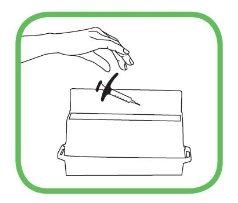
- Тримайте контейнер поза зоною видимості та досягнення дітей.
- Якщо вам потрібно зробити другу ін'єкцію, як призначив ваш лікар, повторіть процес ін'єкції, починаючи з кроку 2.
- Країна реєстрації
- Діючі речовини
- Потрібен рецептТак
- Виробник
- Інформація є довідковою і не є медичною порадою. Перед прийомом будь-яких препаратів обов'язково проконсультуйтеся з лікарем. Oladoctor не несе відповідальності за медичні рішення, прийняті на основі цього контенту.
- Альтернативи до Цимзія 200 мг розчин для ін'єкцій у попередньо заповненому шприціФорма випуску: РОЗЧИН ДЛЯ ІН'ЄКЦІЙ, 200 мг/млДіючі речовини: certolizumab pegolВиробник: Ucb PharmaПотрібен рецептФорма випуску: РОЗЧИН ДЛЯ ІН'ЄКЦІЙ, 200 мг/млДіючі речовини: certolizumab pegolВиробник: Ucb PharmaПотрібен рецептФорма випуску: РОЗЧИН ДЛЯ ІН'ЄКЦІЙ, 20 мгДіючі речовини: adalimumabВиробник: Amgen Europe B.V.Потрібен рецепт
Лікарі онлайн щодо Цимзія 200 мг розчин для ін'єкцій у попередньо заповненому шприці
Консультація щодо дозування, побічних ефектів, взаємодій, протипоказань та поновлення рецепта на Цимзія 200 мг розчин для ін'єкцій у попередньо заповненому шприці – за рішенням лікаря та згідно з місцевими правилами.




